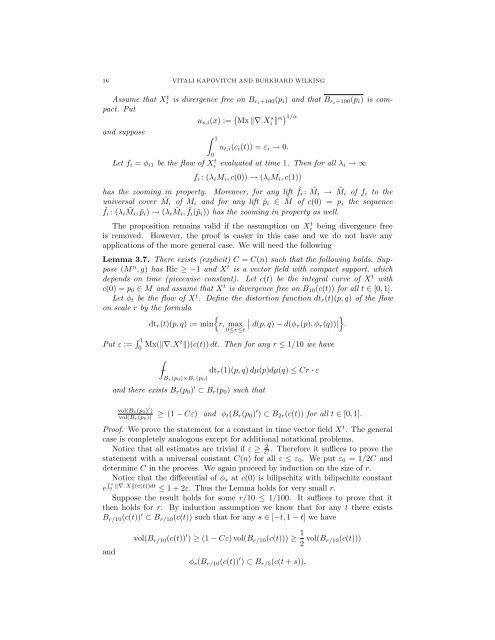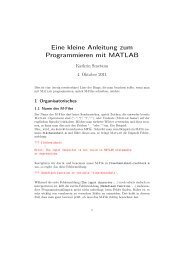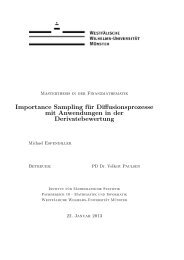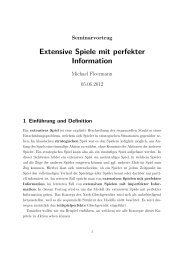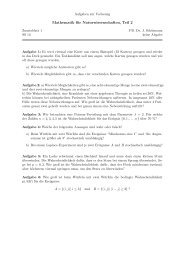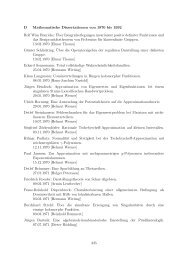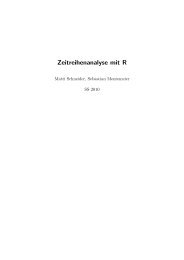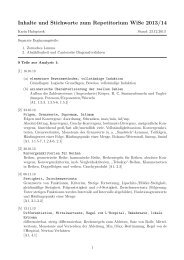Margulis Lemma
Margulis Lemma
Margulis Lemma
You also want an ePaper? Increase the reach of your titles
YUMPU automatically turns print PDFs into web optimized ePapers that Google loves.
16 VITALI KAPOVITCH AND BURKHARD WILKING<br />
Assume that Xi<br />
t is divergence free on B r i+100(p i ) and that B ri+100(p i ) is compact.<br />
Put<br />
u s,i (x) := ( Mx ‖∇·Xi s ‖ α) 1/α<br />
and suppose<br />
∫ 1<br />
0<br />
u t,i (c i (t)) = ε i → 0.<br />
Let f i = φ i1 be the flow of X t i evaluated at time 1. Then for all λ i → ∞<br />
f i : (λ i M i , c(0)) → (λ i M i , c(1))<br />
has the zooming in property. Moreover, for any lift ˜fi : ˜Mi → ˜M i of f i to the<br />
universal cover ˜Mi of M i and for any lift ˜p i ∈ ˜M of c(0) = p i the sequence<br />
˜f i : (λ i ˜Mi , ˜p i ) → (λ i ˜Mi , ˜f i (˜p i )) has the zooming in property as well.<br />
The proposition remains valid if the assumption on Xi<br />
t being divergence free<br />
is removed. However, the proof is easier in this case and we do not have any<br />
applications of the more general case. We will need the following<br />
<strong>Lemma</strong> 3.7. There exists (explicit) C = C(n) such that the following holds. Suppose<br />
(M n , g) has Ric ≥ −1 and X t is a vector field with compact support, which<br />
depends on time (piecewise constant). Let c(t) be the integral curve of X t with<br />
c(0) = p 0 ∈ M and assume that X t is divergence free on B 10 (c(t)) for all t ∈ [0, 1].<br />
Let φ t be the flow of X t . Define the distortion function dt r (t)(p, q) of the flow<br />
on scale r by the formula<br />
{<br />
}<br />
dt r (t)(p, q) := min r, max ∣ d(p, q) − d(φ τ (p), φ τ (q))| .<br />
0≤τ≤t<br />
Put ε := ∫ 1<br />
0 Mx(‖∇·X t ‖)(c(t)) dt. Then for any r ≤ 1/10 we have<br />
∫<br />
−<br />
dt r (1)(p, q) dµ(p)dµ(q) ≤ Cr · ε<br />
B r(p 0)×B r(p 0)<br />
and there exists B r (p 0 ) ′ ⊂ B r (p 0 ) such that<br />
vol(B r(p 0) ′ )<br />
vol(B r(p 0))<br />
≥ (1 − Cε) and φ t (B r (p 0 ) ′ ) ⊂ B 2r (c(t)) for all t ∈ [0, 1].<br />
Proof. We prove the statement for a constant in time vector field X t . The general<br />
case is completely analogous except for additional notational problems.<br />
Notice that all estimates are trivial if ε ≥ 2 C<br />
. Therefore it suffices to prove the<br />
statement with a universal constant C(n) for all ε ≤ ε 0 . We put ε 0 = 1/2C and<br />
determine C in the process. We again proceed by induction on the size of r.<br />
Notice that the differential of φ s at c(0) is bilipschitz with bilipschitz constant<br />
e R s<br />
0 ‖∇·X‖(c(t))dt ≤ 1 + 2ε. Thus the <strong>Lemma</strong> holds for very small r.<br />
Suppose the result holds for some r/10 ≤ 1/100. It suffices to prove that it<br />
then holds for r. By induction assumption we know that for any t there exists<br />
B r/10 (c(t)) ′ ⊂ B r/10 (c(t)) such that for any s ∈ [−t, 1 − t] we have<br />
and<br />
vol(B r/10 (c(t)) ′ ) ≥ (1 − Cε) vol(B r/10 (c(t))) ≥ 1 2 vol(B r/10(c(t)))<br />
φ s (B r/10 (c(t)) ′ ) ⊂ B r/5 (c(t + s)),


